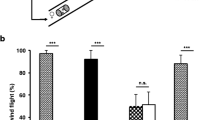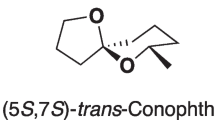Abstract
The two major yeasts isolated from the southern pine beetle,Dendroctonus frontalis Zimmerman, areHansenula holstii Wickerham andPichia pinus (Hoist) Phaff; a third yeast,P. bovis van Uden et do Carmo-Sousa, has been isolated far less frequently. The main volatile metabolites produced by these yeasts are isoamyl alcohol, isoamyl acetate, 2-phenylethanol, and 2-phenylethyl acetate.We have found that certain of these compounds, particularly the esters, can greatly, enhance the attractiveness of a mixture of frontalin:trans-verbenol: turpentine (1:1:12), at certain limiting concentrations, to walking beetles in a laboratory bioassay.
Similar content being viewed by others
References
Anderson, R.F. 1948. Host selection by the pine engraver.J. Econ. Entomol. 41:596–602.
Barras, S.J., andPerry, T. 1972. Fungal symbionts in the prothoracic mycangium ofDendroctonus frontalis (Coleoptera:Scolytidae).Z. Angew. Entomol. 71:95–104.
Brand, J.M., Bracke, J.W., Markovetz, A.J., Wood, D.L., andBrowne, L.E. 1975. Production of verbenol pheromone by a bacterium isolated from bark beetles.Nature 254:136–137.
Brand, J.M., Bracke, J.W., Britton, L.N., Markovetz, A.J., andBarras, S.J. 1976. Bark beetle pheromones: Production of verbenone by a mycangial fungus ofDendroctonus frontalis.J. Chem. Ecol. 2:195–199.
Cade, S.C., Hrutfiord, B.F., andGara, R.I. 1970. Identification of a primary attractant forGnathotrichus sulcatus isolated from western hemlock logs.J. Econ. Entomol. 63: 1014–1015.
Dworkin, M., andFoster, J.W. 1958. Experiments with some microorganisms which utilize ethane and hydrogen.J. Bacteriol. 75:592–603.
Francke-Grosmann, H. 1963. Some new aspects in forest entomology.Annu. Rev. Entomol. 8:415–438.
Gouger, R.J. 1972. Interrelationships ofIps avulsus (Eichh.) and associated fungi.Diss. Abstr. 32:6453-B.
Graham, K., 1967. Fungal-insect mutualism in trees and timber.Annu. Rev. Entomol. 12: 105–126.
Graham, K. 1968. Anaerobic induction of primary chemical attractancy for ambrosia beetles.Can. J. Zool. 46:905–908.
Holst, E.C. 1936.Zygosaccharomyces pini, a new species of yeast associated with bark beetles in pines.J. Agric. Res. 53:513–518.
Lodder, J. 1970. The Yeasts. North-Holland Publishing Company, Amsterdam.
Moeck, H.A. 1970. Ethanol as the primary attractant for the ambrosia beetle,Trypodendron lineatum (Coleoptera:Scolytidae).Can. Entomol. 102:985–995.
Moeck, H.A. 1971. Field tests of ethanol as a scolytid attractant. Bimonthly Research Notes, Dept. of Fisheries & Forestry, Canada. 27:11–12.
Payne, T.L., Hart, E.R., Edson, L.J., McCarty, F.A., Billings, P.M., andCoster, J.E. 1976. Olfactometer for assay of behavioral chemicals for the southern pine beetle,Dendroctonus frontalis (Coleoptera:Scolytidae).J. Chem. Ecol. 2:411–420.
Person, H.L. 1931. Theory in explanation of the selection of certain trees by the western pine beetle.J. For. 29:696–699.
Renwick, J.A.A., Pitman, G.B., andVité, J.P. 1976. 2-Phenylethanol isolated from bark beetles.Naturwissenschaften 63:198.
Shifrine, M., andPhaff, H.J. 1956. The association of yeasts with certain bark beetles.Mycologia 48:41–55.
Suomalainen, H. 1969. Trends in physiology and biochemistry of yeasts.Antonie van Leeuwenhoek, Vol. 35,Supplement: Yeast Symposium 1969, pp. 83–111.
Vité, J.P. andGara, R.I. 1962. Volatile attractants from ponderosa pine attacked by bark beetles (Coleoptera: Scolytidae).Contrib. Boyce Thompson Inst. 21:251–273.
Vité, J.P., Gara, R.I., andKliefoth, R.A. 1963. Collection and bioassay of a volatile fraction attractive toIps confusus (LeC.) (Coleoptera:Scolytidae).Contrib. Boyce Thompson Inst. 22:39–50.
Whitney, H.S. 1971. Association ofDendroctonus ponderosae (Coleoptera: Scolytidae) with blue stain fungi and yeasts during brood development in lodgepole pine.Can. Entomol. 103:1495–1503.
Wood, D.L. 1972. The selection and colonization of ponderosa pine by bark beetles, pp. 101–117,in H.F. van Emden (ed.). Insect/Plant Relationships. Blackwell Scientific Publications, London.
Wood, D.L., andVité, J.P. 1961. Studies on the host selection behavior ofIps confusus (LeConte) (Coleoptera: Scolytidae) attackingPinus ponderosa.Contrib. Boyce Thompson Inst. 21:79–95.
Author information
Authors and Affiliations
Additional information
Supported in part by cooperative agreement No. 19-205 with the USDA Forest Service, Southern Forest Experiment Station, Pineville, Louisianna 71360, the Texas Agricultural Experiment Station Project MS 1525, and the USDA-sponsored program entitled ‘The Expanded Southern Pine Beetle Research and Applications Program’ through CSRS grant 516-15-70. The findings, opinions, and recommendations reported herein are those of the authors, and not necessarily those of the USDA.
Rights and permissions
About this article
Cite this article
Brand, J.M., Schultz, J., Barras, S.J. et al. Bark-beetle pheromones. J Chem Ecol 3, 657–666 (1977). https://doi.org/10.1007/BF00988065
Received:
Revised:
Issue Date:
DOI: https://doi.org/10.1007/BF00988065




